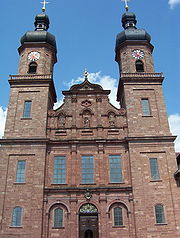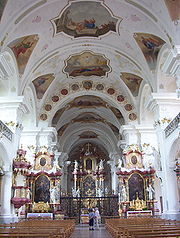
St. Peter's Abbey in the Black Forest
Encyclopedia


Order of Saint Benedict
The Order of Saint Benedict is a Roman Catholic religious order of independent monastic communities that observe the Rule of St. Benedict. Within the order, each individual community maintains its own autonomy, while the organization as a whole exists to represent their mutual interests...
monastery in the village of St. Peter im Schwarzwald
Sankt Peter, Baden-Württemberg
Sankt Peter is a town in the district of Breisgau-Hochschwarzwald in Baden-Württemberg in Germany.-External links:...
, in the district of Breisgau-Hochschwarzwald
Breisgau-Hochschwarzwald
Breisgau-Hochschwarzwald is a district in the south of Baden-Württemberg, Germany. Neighboring districts are Emmendingen, Schwarzwald-Baar, Waldshut, Lörrach and the French départements of the Haut-Rhin and the Bas-Rhin. The district-free city of Freiburg is surrounded by the district...
, Baden-Württemberg
Baden-Württemberg
Baden-Württemberg is one of the 16 states of Germany. Baden-Württemberg is in the southwestern part of the country to the east of the Upper Rhine, and is the third largest in both area and population of Germany's sixteen states, with an area of and 10.7 million inhabitants...
, Germany
Germany
Germany , officially the Federal Republic of Germany , is a federal parliamentary republic in Europe. The country consists of 16 states while the capital and largest city is Berlin. Germany covers an area of 357,021 km2 and has a largely temperate seasonal climate...
.
History
The monastic community of St. Peter's was a family monastery and burial place of the Zähringen family. It was originally founded in WeilheimWeilheim an der Teck
Weilheim an der Teck is a town in the district of Esslingen in Baden-Württemberg in southern Germany. It is situated 7 km southeast of Kirchheim unter Teck, and 13 km southwest of Göppingen.-References:...
, in or before 1073, but was forced by hostile military action during the Investiture Controversy
Investiture Controversy
The Investiture Controversy or Investiture Contest was the most significant conflict between Church and state in medieval Europe. In the 11th and 12th centuries, a series of Popes challenged the authority of European monarchies over control of appointments, or investitures, of church officials such...
to move to Hirsau
Hirsau
Hirsau is a district of the town of Calw in the German state of Baden-Württemberg, located in the south-west portion of the country, about two miles north of Calw and about twenty four miles west of Stuttgart.-Town:...
. Duke Berthold II of Zähringen
Berthold II, Duke of Swabia
Berthold II was the Duke of Swabia from 1092 to 1098.Berthold was a son of Berthold II, Duke of Carinthia and initially supported Rudolf of Rheinfelden against King Henry IV. Both the Zähringer and Rheinfeldener were relieved of their titles and possessions by the king in 1077...
(1078–1111) re-founded it as a family monastery, but decided in about 1090 to move it to the site which is now St. Peter im Schwarzwald.
Here it soon developed as a reformed Benedictine monastery directly answerable to the papacy, as witness for example the privilege of Pope Urban II
Pope Urban II
Pope Urban II , born Otho de Lagery , was Pope from 12 March 1088 until his death on July 29 1099...
of 10 March 1095. The Vögte
Vogt
A Vogt ; plural Vögte; Dutch voogd; Danish foged; ; ultimately from Latin [ad]vocatus) in the Holy Roman Empire was the German title of a reeve or advocate, an overlord exerting guardianship or military protection as well as secular justice...
(lords protectors) were initially the Zähringen family but, in the late 13th century, they were succeeded by the Counts of Urach, against whom the monks were eventually obliged to seek the protection of Emperor Charles IV
Charles IV, Holy Roman Emperor
Charles IV , born Wenceslaus , was the second king of Bohemia from the House of Luxembourg, and the first king of Bohemia to also become Holy Roman Emperor....
. In 1526 the office passed to the Habsburgs.
By the gift of the Zähringen family and their ministeriales
Ministerialis
Ministerialis ; a post-classical Latin word, used in English, meaning originally servitor, agent, in a broad range of senses...
the abbey acquired substantial property, particularly in the 11th and 12th centuries, located in the immediate area, in the Breisgau
Breisgau
Breisgau is the name of an area in southwest Germany, placed between the river Rhine and the foothills of the Black Forest around Freiburg im Breisgau in the state of Baden-Württemberg. The district Breisgau-Hochschwarzwald, which partly consists of the Breisgau, is named after that area...
and in the Baar region, near Weilheim. The abbey, like most other landowners of the time, suffered significant loss of income and tenants after the middle of the 14th century.
The abbey suffered disastrous fires in 1238 and again in 1437. It lost importance in the later mediaeval period, and the monastic reforms of the 15th century had little effect here. Nevertheless, it managed to keep its property intact, even through the troubles of the Reformation
Protestant Reformation
The Protestant Reformation was a 16th-century split within Western Christianity initiated by Martin Luther, John Calvin and other early Protestants. The efforts of the self-described "reformers", who objected to the doctrines, rituals and ecclesiastical structure of the Roman Catholic Church, led...
. The premises were re-built in Baroque
Baroque
The Baroque is a period and the style that used exaggerated motion and clear, easily interpreted detail to produce drama, tension, exuberance, and grandeur in sculpture, painting, literature, dance, and music...
style in the 17th and 18th centuries; the present church with the two onion towers ("Zwiebeltürme") was built in the 1720s. The architect was Peter Thumb
Peter Thumb
Peter Thumb was an Austrian architect whose family came from the Vorarlberg, the westernmost part of Austria. He is best known for his Rococo architecture, mainly in Southern Germany...
, and the opulent Baroque decoration was by Franz Joseph Spiegler
Franz Joseph Spiegler
Franz Joseph Spiegler was a German Baroque painter. He is best known for his frescoes, which decorate many of the churches and monasteries along the Upper Swabian Baroque Route. The frescoes in the Zwiefalten Abbey are considered his masterpiece.Spiegler was born the Free Imperial City of Wangen...
(55 frescoes, 1727) and Joseph Anton Feuchtmayer
Joseph Anton Feuchtmayer
Joseph Anton Feuchtmayer was an important Rococo stuccoist and sculptor, active in southern Germany and Switzerland....
(sculptures), among other artists and craftsmen. Peter Thumb also constructed the library. The abbey was dissolved in the secularisation of 1806.
Abbots to 1544
- Adalbero (1093–1100)
- Hugo I (1100–08)
- Eppo (1108–32)
- Gozmann (1132–37)
- Markward (1154–83)
- Rudolf of Reutenhalden (1183–91)
- Berthold I (1191–1220)
- Heinrich I (1220–55)
- Arnold (1255–75)
- Walther I (1275–91)
- Eberhard (1291–95)
- Gottfried of Lötschibach (1295–1322)
- Berthold II (1322–49)
- Walther II (1350–53)
- Johannes I of Immendingen (1353–57)
- Peter I of Thannheim (1357–66)
- Jakob I Stahelin (1367–80)
- Hugo II (1380–82)
- Heinrich II of Stein (1382–90)
- Heinrich III Salatin (1390–92)
- Johannes II of Stein (1392)
- Erhard (1392–1401)
- Benedikt I of Thannheim (1401–02)
- Johannes III (1402–04)
- Johannes IV Kanzler (1404–09)
- Heinrich IV von Oettlingen (1409–14)
- Heinrich V von Hornberg (1414–27)
- Johannes V Tüffer (1427–39)
- Jakob II von Altensummerau (1439–43)
- Konrad von Hofen (1443–49)
- Burkhard von Mansberg (1449–53)
- Johannes VI von Küssenberg (1453–69)
- Peter II Emhardt (1469–92)
- Simon Budner (1492–96)
- Peter III Gremmelsbach (1496–1512)
- Jodocus Kaiser (1512–31)
- Adam Guldin (1531–44)
Abbots of the Early Modern period include:
- Philipp Jakob Steyrer (1749–95)
- Ignaz Speckle (1795–1806)

